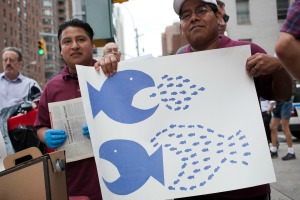By Brad Weismann.
The success rate is dismal. All the rules have changed. How does a film festival feel its way forward? The Boulder International Film Festival (BIFF), which took place this year from March 5th through March 8th, began its second decade by keeping its head down and sticking to the basics. It has been 25 years since the Great Film Festival Boom began in North America. Events that were formerly seen as an amusement strictly for the effete elite became game-changers, spectator sports, tidal experiences that identified ability, rewarded innovation, promoted networking, and, most importantly, made money. It seemed that anyone and everyone could create a film festival.
However, the boom is currently losing velocity. In 2014, American screening attendance was measured at its lowest annually since 1995. Stephen Follows’ masterly 2013 historical analysis of the business of film festivals demonstrates the overall waning popularity of the trend, despite the status and influence of the Big Four—Sundance, Toronto, Tribeca, and South by Southwest—and trendsetters such as True/False. The economics, technology, distribution, and marketing of film have all changed since Steven Soderbergh legitimized Sundance as a player in the world cinema system. Given the fact that less than 25% of film festivals survive their sixth year, and the rampant, incessant changes the industry is buffeted by, the path ahead is fogbound.
BIFF was conceived by two sibling documentary filmmakers, Kathy and Robin Beeck, and debuted in 2005. Its locale is a mixed bag. Boulder, Colorado is a university-centered, high-tech, affluent, predominately Caucasian, extrovert, spiritually obsessed, outdoors-loving, rock-climbing, dog-owning, Frisbee-tossing, dope-smoking community of slightly more than 100,000 nestled against the Rocky Mountains—a liberal oasis in a largely conservative state.
It presents two distinct challenges to long-term viability: a dearth of a central arts district, or even enough venues of sufficient size, and an economic phenomenon known as “the Boulder bubble” which precludes much cultural traffic between it and the state’s adjacent population center, the state capitol Denver, which houses 3 million. The overlap is so minimal that many films that first screened at the Denver International Film Festival four months earlier find their way into BIFF’s program as well, with no discernible financial impact. Here, premieres are passé.
Throughout the festival’s history, it has strayed neither in scope nor in theme. It has screened around 50 films each year since its inception, and its populist, documentary-heavy programming emphasizes offerings containing humor, nostalgia, music, adventure, social action, and sentiment. And that is no easy feat. Having been in on the selection process in the past, this writer can personally attest that though the digital revolution has put the means of production into everyone’s hands, there has not been a discernible rise in the percentage of quality submissions to a film festival. This winning attunement to local taste has ensured a steady growth rate in ticket sales through the years. Hard numbers not being in yet, the BIFF projection for this year as of press time is flat, despite 15 sold-out shows. While other festivals have transformed themselves into marketplaces, morphed into ever-more-specialized niche coverage, BIFF maintains a generic, open-handed stance. By committing to a broad template for acceptance—that which will play—the festival abandons any pretense of an agenda, launching what it can as well as it can.
The event centers on big Opening and Closing Night events, parties, and interaction with visiting filmmakers. This year, the festival began with Danny Tedesco’s upbeat music documentary The Wrecking Crew (2008), and featured the director in conversation following. 42 other directors, writers, and producers were in attendance, the highest proportion to date at the festival. Another important element is the Call2Action initiative, now being rebranded as TalkBack. In it, community activists and advocates versed in the subject of a documentary lead talkback sessions after the film in question, and go further by presenting opportunities for action and involvement. A partnership with eTown, a nationally syndicated music-and-environment radio show, has provided the festival another exhibition space, as well as a livestreaming Global Town Hall.
Astute community marketing has identified and attracted film-subject-related audiences. And the most active year-round elements of the festival are youth and senior programs that enter schools and centers for the elderly, engaging the respective inmates with films and discussion. During the festival itself, a Youth Pavilion features screenings, workshops, and a filmmaking competition, created with direct student involvement. A similar “CU@BIFF” program is produced by students at the University of Colorado, the film program of which has made rapid strides since the days when Stan Brakhage roamed the halls.
Festival features at BIFF develop by and large informally, organically and opportunistically. The association with Boulder’s RealD 3D technology company has led to 3D screenings such as this year’s Home, complete with and appearance by the film’s director Tim Johnson, and two rubber-suit-enveloped characters from the film, who shuffled awkwardly around the streets in 20-minute stints, to prevent fainting even in the brisk 40-degree-Fahrenheit weather. Some of the event’s most robust elements seem the most tangential: a singer/songwriter showcase, food-and-film pairings and special events, and an opening-night costume parade that features two dozen performers made up as film characters. A centerpiece of the festival is a spotlight on a visiting filmmaker or actor. These take the form of a tribute, and usually someone in the latter part of his or her career. The average age of the celebrated individual is around 69; this year’s honoree was a pleasant and well-spoken Alan Arkin, age 80.
The festival’s Closing Night has become increasingly devoted to documentaries by Colorado filmmakers. The region has birthed an impressive list of them—Daniel Junge, who screened his new Being Evel this year; Paula DuPre Pesmen, who showed Keep on Keepin’ On last year, and Jeff Orlowski, whose Chasing Ice closed the fest previously. This year, it featured Racing Extinction by the Oscar-winning director Louie Psihoyos of The Cove (2009). Like its predecessor, it takes the form of an eco-caper, complete with an electric car containing a pop-up digital projector, which was used to project pictures and information concerning endangered species and environmental degradation on the side of large buildings in the area.
The virtue of the festival lies not in these highly-touted events. It’s the less-trumpeted gems that keep it fresh. This year, those films included Robin Blotnick and Rachel Lears’ The Hand That Feeds, concerning a unionization effort by immigrant food workers; Bobcat Goldthwait’s Call Me Lucky, a portrait of the acerbic and abused American comic Barry Crimmins; Jim Aikman’s Jeff Lowe’s Metanoia, concerning a crippled champion climber; and Daniel Glick’s A Place to Stand, a portrait of former convict and poet Jimmy Santiago Baca. That all the films cited had a live filmmaker there to interact with the crowd and each other is representative of how the festival cannily exploits the single irreplaceable attribute of a film festival—the in-person, here-and-now of it.
In this, BIFF shares the philosophy of another geographically isolated, venue-challenged festival—the Cucalorus Film Festival in Wilmington, North Carolina. Prizeless, celebrity-bereft, Cucalorus maintains a down-home, relaxed, and enthusiastic atmosphere without a lot of foofaraw that makes it simply a pleasant place to spend time, see movies, and have fun. Reactive rather than programmatic, BIFF moves with caution while attempting to retain a homey, aw-shucks feel that has much more to do with what people want to see than what the industry wants to get seen. Perhaps this kind of hyperlocal focus can create a steady patronage that will enable the festival to remain a standalone revenue generator. So far, it’s worked.
Brad Weismann is a writer and editor based in Boulder, Colorado. He contributes to sites and publications such as Film International, Senses of Cinema, Muso, 5280, and more.




